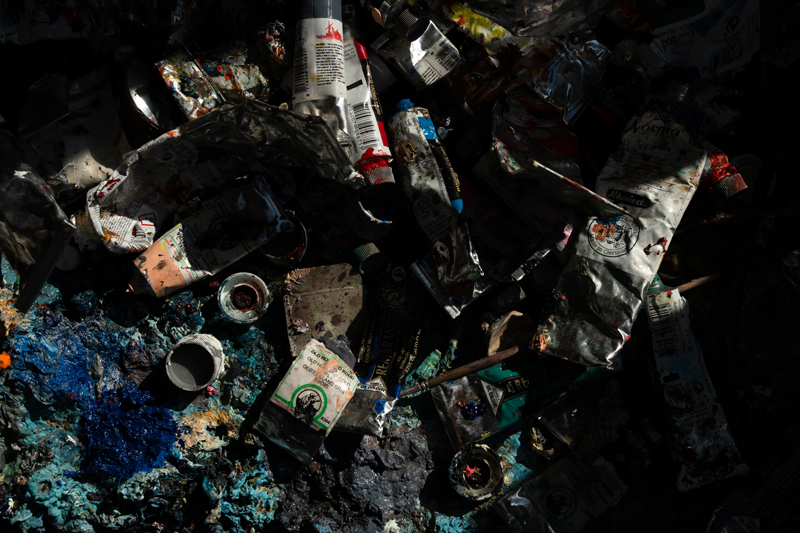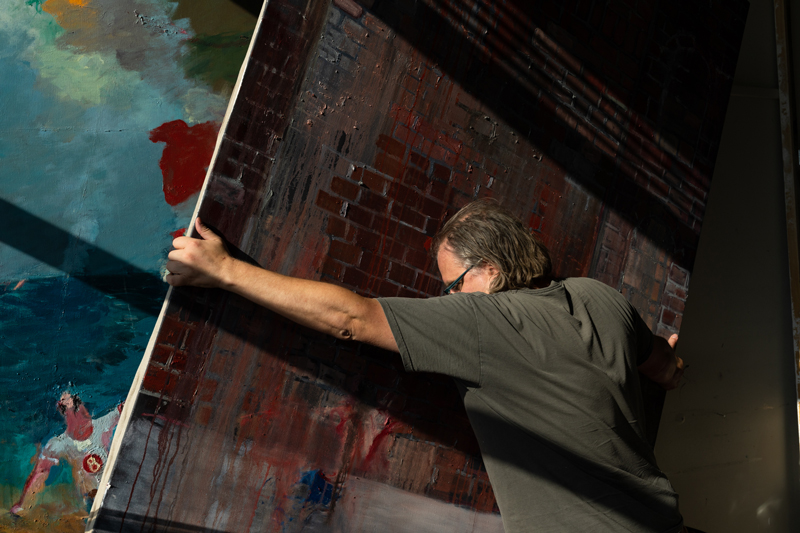22 august 2023, Wouter van den Eijkel
The studio of... Aaron van Erp
Aaron van Erp has two studios, one in Eindhoven and one in Asuncion, Paraguay. Van Erp recently completed a residency close to home at the Vincent van Gogh House in Zundert. In his work, Van Erp often makes reference to the work of other painters, so he seized the opportunity to engage in dialogue with Van Gogh’s oeuvre. This resulted in larger works than we are used to from Van Erp. The new works look a bit unfinished. He comments, “I find a painting at its most interesting when it is not quite finished. Perhaps because it depicts a world that is equally unfinished.” Together with other recent work, the works from Zundert will be on display from September at the Livingstone Gallery in The Hague.
Your gallerist told me that you have two studios, one in Eindhoven and one in the capital of Paraguay, Asuncion. You probably don’t get many questions about the first, but a lot more about the second. How did you end up in Asuncion and what made you decide to have a studio there?
My girlfriend and my daughter live in Paraguay, which is why I spend a few months there every year. In 2018 and 2019, I had even terminated the contract for my studio in the Netherlands and worked entirely from Paraguay, except for a stint at Livingstone Projects Berlin (Livingstone Gallery’s project space in Berlin). But since the end of 2019, I have a studio in Eindhoven again.
Can you describe your studios?
In Paraguay, I mainly do drawings with ink and acrylic paint on paper. My workplace there is very simple. It's more of an easel with a plywood sheet on it onto which I adhere large sheets of paper. I often use sheets of brown wrapping paper that come in the standard size of 87x115cm. I also have a second plywood sheet so I can easily switch between drawings because I like to work on several pieces at the same time. I put the drawing and plywood sheet against the wall and the other one on the easel.
The Eindhoven studio is a pure oil painting studio. In other words, it’s very different from my drawing studio. In addition, in Paraguay I close up my workplace when I'm not there, so that the space can be used for something else, so I always make a fresh start. In Eindhoven, the studio is continuously occupied by my clutter, with more clutter being added all the time.

Photo by Ralph Roelse
Would you say that you create different work in Asuncion than in Eindhoven?
Besides the difference between drawings and paintings, some local visual elements sometimes creep into the works from Paraguay, such as trees with the lower part of the trunk painted white or large pieces of meat from Paraguayan barbecue culture.
You recently did a residency at the Van Gogh house in Zundert. Unlike Asuncion, Zundert is less than an hour's drive from Eindhoven. Why did you want to do that residency?
The idea of engaging in dialogue with Van Gogh's work appealed to me. I have often made work based on the work of other painters, such as Velazquez, Ingres and Delacroix, so I thought the idea behind the Van Gogh residency would be perfect for my working method.

Aaron van Erp, Selfie met mondmasker en zak houtskool, 2020, Livingstone Gallery
What was your goal and did you achieve it?
The Vincent van Gogh House studio is a lot larger than the space I have in Eindhoven, so I took the opportunity to make work that would not fit in my Eindhoven studio.
Apart from the fact that you are/were both painters, do you see any similarities between your work and Van Gogh's?
As a painter, you can't help but have great admiration for Van Gogh's work, but I discovered that I am a very different kind of painter than Van Gogh was. I like to have a kind of narrative or literary element in my work that I found difficult to find in Van Gogh’s work. In the end, I started working with work that Van Gogh himself painted based on other artists, such as the Prison Courtyard by Doré and the Good Samaritan by Delacroix, where I could find that narrative element.

Aaron van Erp, The Samaritan (after Van Gogh, after Delacroix), 2023, Livingstone Gallery
You just mentioned that you like to have a narrative element in your work. What exactly do you mean by that?
When I say a literary or narrative element, I don't necessarily mean that I have a finished story to tell, but rather that, as the viewer, you get a sense of dropping into the middle of a story you may not understand. My favourite writers – Kafka, Conrad, Beckett and Borges – often have a sense of absurdity about them. The loose ends just don't come together. I also find a painting at its most interesting when it is not (yet) quite finished. That's why my work often looks unfinished. In a sense, it's not finished either. Perhaps because it depicts a world that is also unfinished.
Your paintings almost invariably have a black background against which a scene or part of a scene is taking place. How did you come up with this?
The black backgrounds are mainly from a specific period, namely from 2011 to 2017, which was my Caravaggio worship period. I also used black gesso for a while because I don't like starting on a stark white background like you have with regular gesso. In newer work, I don’t often use a black background. I sometimes use transparent gesso, which gives the background the colour of raw linen, or a combination of white gesso, black gesso and acrylic paint.

Aaron van Erp, Stilleven met tentakel en Kikkomansaus, 2020, Livingstone Gallery
Absurdism and (black) humour play a role in your work. This is evident from the extensive titles you give your works, such as Proefopstelling voor een installatie over beenham (Test setup for an installation about ham) or Interview met de assistent van een omstreden abortusarts (Interview with the assistant of a controversial abortion doctor). At what point did you discover you could use such humour in your work?
could use such humour in your work? Titles often come afterwards, when a certain distance has already arisen between me and the work. That allows the opportunity for some irony.
About the work The cowardly attack on Igor Strelkov (Strelkov was convicted in absentia for downing flight MH-17 over Ukraine and has now been arrested in Russia for criticising Putin, ed.). Is it true that your works sometimes refer indirectly to current events?
The Igor Strelkov painting is a bit of an extreme example of topicality. I'm not often that explicit. Usually, associations with current events arise afterwards, just like the titles. Then everything that haunts my head creeps into the work and current events are often a part of that.

Aaron van Erp, Zonder Titel, 2019, from the series Paraguay Drawings, Livingstone Gallery
Next month, you’ll have a solo show at Livingstone Gallery in The Hague. What can we expect?
In September at the Livingstone Gallery, there will be a number of works from my time in Zundert, such as The Good Samaritan who does not yet know that he will go down in history as the Good Samaritan, my version of Van Gogh’s The Good Samaritan (after Delacroix) and there will be a number of works I made during my residency, where I continue the theme of the brick courtyard from Van Gogh and Doré’s work.
What are you currently working on?
I'm still working on the exhibition for Livingstone. I don’t think all the paint will be completely dry by the time of the exhibition.

Photo by Ralph Roelse
